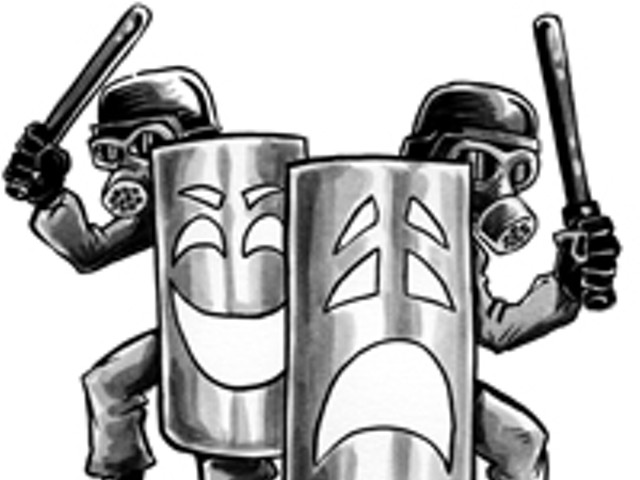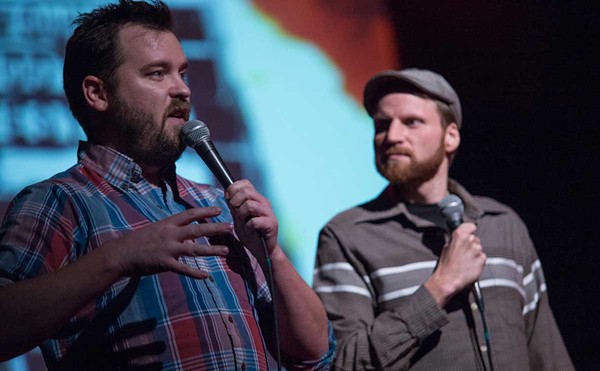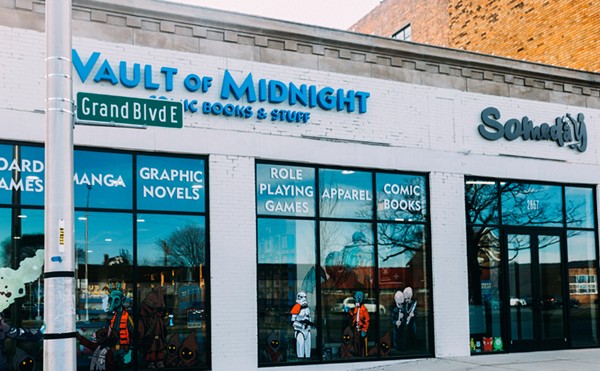"In New York," says Matthew Higgs, director and chief curator of the city’s not-for-profit gallery White Columns, "someone who organizes an exhibition can rely on a certain bedrock experience, and, extending from that, a conditioned response." The prolific curator, artist, and writer was in his windowless, record-and-art filled office at the southernmost reaches of Chelsea, discussing Words Fail Me, the group exhibition he’s organized for the Museum of Contemporary Art Detroit. "We’re so familiar with Jack Pierson’s sculptures made of found signage that we’ve even seen them parodied in the Barney’s shop window. One of the fascinating things about Detroit is that the work of many of these artists is being seen locally for the first time. It certainly changed how I view a lot of the work in the show, and some of the inclusions were influenced by my visits to the city, which looks very similar to the area in which I grew up in the north of England."
Words Fail Me, the second exhibition to be organized specifically for the museum by an outside curator, includes 16 artists and artist groups, from Tauba Auerbach, a San Francisco–based artist in her mid-20s, to Peter Fischli and David Weiss, eminent Swiss artists who have represented their country at the Venice Biennale and been the subject of several career surveys, most recently at London’s Tate Modern. What unites the disparate text-based artworks —videos, a neon piece, a nearly invisible sculpture made of pushpins, piles of posters free for the taking, a mural-size wall painting, a laser — is their engagement with the world outside of art. These "vernacular manifestations of language," as Higgs calls them, range from Pierson and Ron Terada’s use of commercial signage to Carl Pope, Jr.’s riffing on the visual conventions of fly-posting and pamphleteering. "Others," Higgs continues, "play off real-world entanglements of the use of language, the way that language manifests itself socially in public space."
What results is "not a survey of art and language, or a survey of works that include language in them. It’s more about a cumulative mood, something that is a little more emotive. One can sense a melancholic acceptance of our present circumstances." Is that where the exhibition’s title comes in? "Yes, to a degree. It seems that we’re at a point where language seems insufficient, or it isn’t enough by itself, however hard one might try to articulate an idea. There is always a potential for it to be misunderstood or misread."
The works in "Words Fail Me" address imperfect communication, often by means of deliberate ambiguity. New York artist Siobhan Liddell’s contribution, "Weakness as strength" (2007), consists of those three words spelled out in clear pushpins on a 24-foot-long white wall. One at first sees a blank surface; only gradually does the message distinguish itself from the background; it will take longer still for each viewer to determine what the message means to him or her. Elsewhere, Jonathan Monk’s "Laser Piece Number VI (Nostalgic for the Future)" (2006) is precisely what the title indicates: A laser that spells out the phrase on the wall. Who provides the speaking voice for this work? Is the speaker nostalgic for an actual future, or for an era when the future seemed to be a bright prospect? Many of the works in the exhibition will prompt such questions; Fischli and Weiss’s piece, a slide projection they have exhibited around the world but reconfigured specifically for this show, consists of nothing but questions, a kind of philosophical graffiti projected from slides onto the walls.
Perhaps one of the most relevant interrogations comes from artist Kay Rosen, a longtime resident of nearby Gary, Ind. "Blurred" (2005) consists of the titular word rendered in eight-foot-tall blocky letters running across the corner where two walls meet. "Blu" is in bright blue; the central "r" is in purple; "red" is, of course, in red. A few years back, University of Michigan professors created U.S. maps that indicated that most of the country is politically neither red nor blue, and it’s to Rosen’s credit that her work counters reductive red state–blue state notions of our electoral affinities without seeming hectoring. As Rosen said in an interview about another recent work of hers, it is "coincidental and amazing that in this word structure corroborates meaning." Rosen, who Higgs cites as influential to his thinking about Words Fail Me and to his own art practice, consistently discovers such felicities.
Also noteworthy is the art work created for the exhibition by London-based artist Jeremy Deller. "Folk Song (detail)" (2007) consists of three piles of posters, free for the taking, printed with an excerpt of a traditional English folk song about patriotism, nationhood and an individual’s relationship to those concepts. The central pile presents the lyrics in English, rendered in the typeface used on the London Underground; to the right they are printed in Arabic; to the left they have been translated into Hebrew. Higgs elaborates: "These letterforms — if we don’t read Arabic or Hebrew — are continually politicized. For example, the Arabic font stops being an elegant, illegible calligraphy and becomes something else instead."
The ways text is incorporated into visual art can be plotted on a spectrum, defined on one end by description and on the other by what one might call counter-description. In the former, text functions as a caption, directly translating, substituting for, or providing additional information about an image; in the latter, language opens the image up to new interpretations (think of René Magritte’s canonical painting "The Treachery of Images" — aka, "This Is Not a Pipe). The majority of Words Fail Me tends toward the latter end of the spectrum, which will prove a boon to viewers worried about facing down dryly conceptual art works —Joseph Kosuth’s canonical Photostats definitions of words like "Abstract" or "Chair" do not figure into the show. "Each one of the works does something quite different formally, physically and experientially … on top of what it’s up to idea-wise or conceptually," Higgs notes. "In a way, they have a theatrical presence."
This is especially true of Pierson’s work, Dead (1996). Installed on a freestanding wall facing the entrance to the museum, "it’s the first work you see when you come in. It has such a visceral punch. Instead of the welcome mat you get an image of closure." Beyond the sculpture, Higgs has installed a series of freestanding walls that divide the large rooms of the former Cadillac dealership into more manageable spaces, which adds to the theatricality.
"I wanted the show to have a complicated group of artists — early, mid-career and established — and to have no hierarchy in the way the work is presented in the space. It’s about your perambulation through the space" and coming up with your own aggregate conversation. If the show is a success, that conversation should reach far beyond MOCAD’s walls. Brian Sholis is Artforum.com editor at Artforum. Send comments to [email protected]





